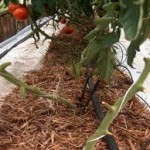 There is a growing interest in alternative growing methods to increase crop production. Part of the reason, is the soil is becoming more depleted of the nutrients needed for plant growth. Over-fertilization, pesticides, and erosion are some of the causes that may contribute to soil problems, lower crop yields, and poor quality vegetables.
There is a growing interest in alternative growing methods to increase crop production. Part of the reason, is the soil is becoming more depleted of the nutrients needed for plant growth. Over-fertilization, pesticides, and erosion are some of the causes that may contribute to soil problems, lower crop yields, and poor quality vegetables.
Many homesteaders, farmers, and home gardeners are now searching for solutions to help increase their plant production and food quality. Their approach is to increase the nutrients that are feeding the growth and development of the plants without adding more chemical fertilizers and pesticides. One method that some homestead gardeners are considering is hydroponic gardening.
Many homesteaders who maintain and garden are actually starting to utilize Hydroponics gardening for many different reasons. Hydroponics gardens are small and can pretty-easily be expanded to grow inside. That means a longer growing season and more crops throughout the year. Hydroponics works great for many varieties of vegetables, and especially the red tomato. Also, the equipment and devices needed for Hydroponics gardening is not at all costly and are extremely simple to handle.
You can get some excellent training and growing resources in a free subscription of PREPARE Magazine.
Simple Description of Hydroponics Gardening:
Hydroponics gardening is the growth and development of plants without the use of soil (dirt), or maybe described as, “dirtless gardening”. There are numerous methods of Hydroponics gardening many of which work much better than regular soil gardening since it is simpler to control and offer the plants exactly what they need when they need it. Plants will just utilize and nourish with exactly what you offer them; therefore you will have the ability to manage the pH, nutrients, nutrient strength, water quantity, and light quantity. This makes it critical that you look into the kind of plants you will be growing so you understand what they should make it through.
Hydroponics gardening operates as simple or as difficult as you make it. It can be complicated if computers with sensors are utilized to manage water cycles, nutrients, and light for the plants. However, it can likewise be as simple as a hand sprinkled container with a single plant. The regular house Hydroponics system is usually made up of a couple of standard things: an expanding tray, light (natural or synthetic), a tank, a water managed pump for watering (or some type of watering devices), and some kind of air pump to provide oxygen to the nutrients.
The growing medium used in Hydroponics gardening can be any variety of things, such as Rockwool, perlite, coconut fiber, gravel, sand, vermiculite, or even air. You can get directions from a gardening store or online or buy different parts and develop your very own. There are also kits already constructed for sale in gardening supply stores.
There are particular micro-nutrients that are necessary for healthy plant growth consisting of magnesium, sulfur, calcium, cobalt, boron, iron, copper, manganese, and zinc. These nutrients are absolutely necessary to plants and if they are not provided could cause the food to not be as healthy and sometimes even trigger health troubles for those who consume it. It is vital that you consider how you are going to provide these mocro-nutrients when Hydroponics gardening. Organic fertilizers, compost teas, or other ways of supplementing the plants is essential.
An additional important aspect of Hydroponics gardening that must be carefully managed is the pH balance. When the pH balance varies the plants will lose the capability to soak up nutrients that it requires. The ease with which the pH in Hydroponics gardening is tested and controlled offer it a big advantage over routine dirt gardening.
Despite the fact that there are hundreds of various variations, Wick, Water Culture, Ebb and Flow, Drip, N.F.T., and Aeroponic are the six most basic kinds of Hydroponics gardening systems. Hydroponics gardening is simple, budget friendly, and you can have fresh production, flowers, herbs & spices all year long!
Related Content
- Growing Your Own Food: An Introduction to Organic Gardening
- Organic Gardening 101: Everything You Need to Know to Get Started
- Self-Reliance 101: Everything You Need to Know About Being Independent
- How to Start Your Own Home Farm: Tips and Tricks
- Your Homestead Organic Gardening Can Improve Your Family’s Health




